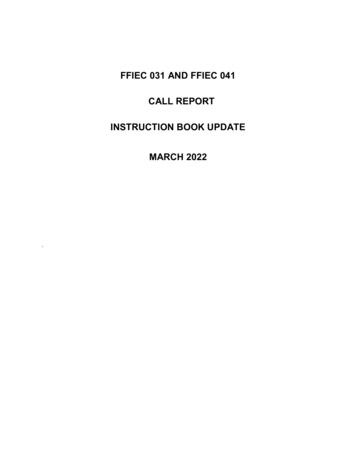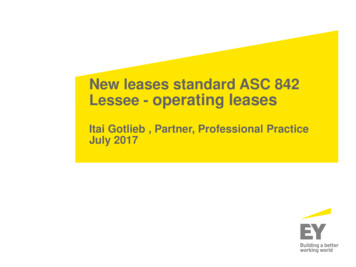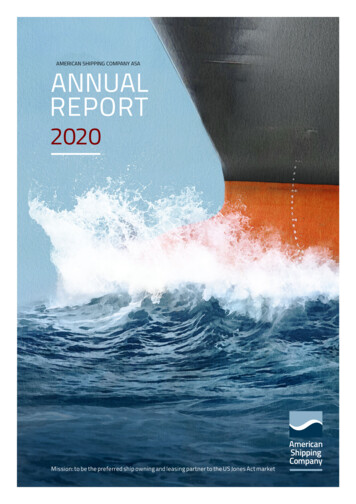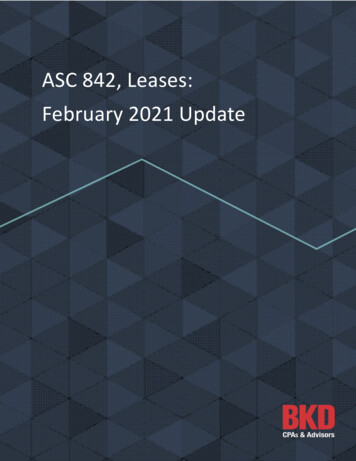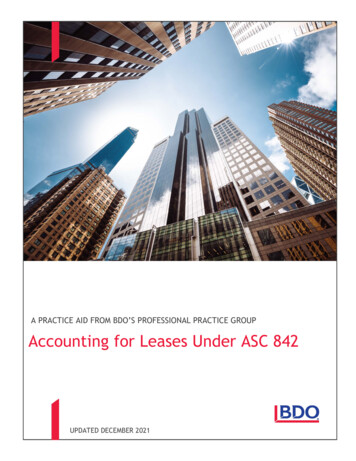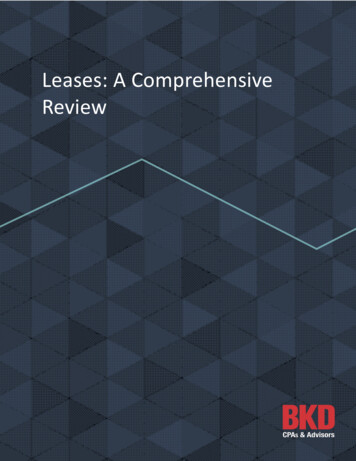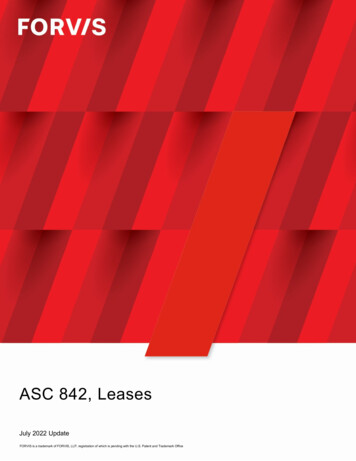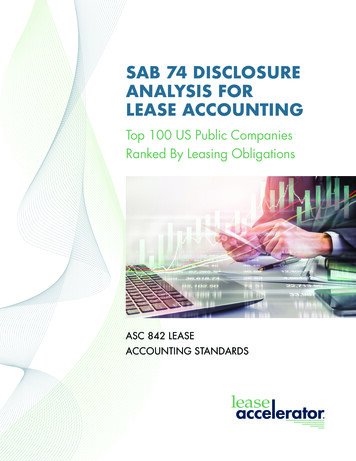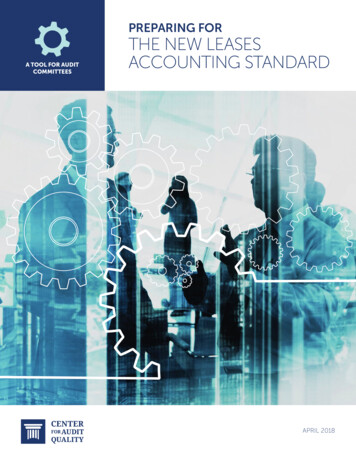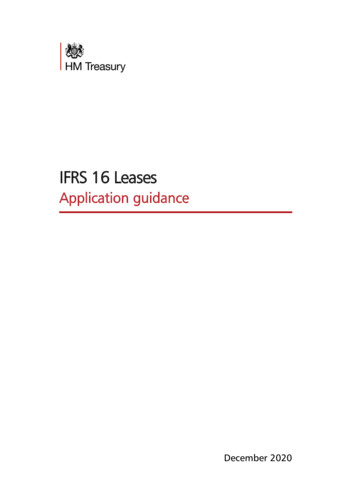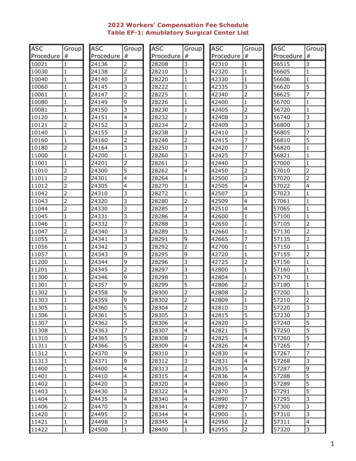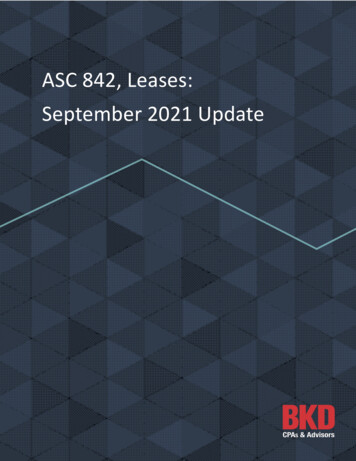
Transcription
Implementing the New Leave AccountingStandardASC 842, Leases:September 2021 Update
ASC 842, Leases: September 2021 UpdateTable of ContentsUPDATE . 4BACKGROUND . 4SCOPE . 6SHORT-TERM LEASES .6LEASE DEFINITION. 7IDENTIFIED ASSET .7RIGHT TO CONTROL .8CONTRACT COMBINATIONS .9CONTRACTS WITH MULTIPLE COMPONENTS . 9LEASE VERSUS NONLEASE COMPONENTS .10SEPARATE RIGHTS OF USE .12LEASE CLASSIFICATION. 12LESSEE .12LESSOR.14INITIAL MEASUREMENT . 16LEASE TERM & OPTIONS .16LEASE COMMENCEMENT .16LEASE PAYMENTS .16LEASE INCENTIVES .18DISCOUNT RATE.18INITIAL DIRECT COSTS .21LESSEE ACCOUNTING . 21OPERATING LEASES.22FINANCE LEASES.22LESSOR ACCOUNTING . 24OPERATING LEASES.24DIRECT FINANCING & SALES-TYPE LEASES .24SUBLEASES . 26BUILD-TO-SUIT TRANSACTIONS . 27SALE-LEASEBACK TRANSACTIONS . 28DETERMINING WHETHER A SALE HAS OCCURRED .28QUALIFIED SALE .29FAILED SALE .30RELATED PARTIES . 302
ASC 842, Leases: September 2021 UpdateREASSESSMENT . 31LEASE MODIFICATION .32CLASSIFICATION REASSESSMENT .34LEASE TERM REASSESSMENT .34RVG .35EXERCISE OF PURCHASE OPTION DURING THE LEASE TERM .35PRESENTATION . 35LESSEE .35LESSOR.38DISCLOSURES . 38LESSEE .39LESSOR.40TRANSITION . 42PRACTICAL EXPEDIENTS .44HINDSIGHT.44IMPAIRMENT & EXIT COST CONSIDERATIONS AT TRANSITION.45BTS TRANSITION.45CONCLUSION . 48CONTRIBUTOR . 48APPENDIX – IDENTIFYING A LEASE . 493
ASC 842, Leases: September 2021 UpdateUpdateThe COVID-19 pandemic has caused unprecedented challenges in all aspects of daily life. In June 2020, FASB issuedAccounting Standards Update (ASU) 2020-05, which provides nonpublic entities and not-for-profits (NFP)additional time to implement Accounting Standards Codification (ASC) 842, Leases.For NFP organizations that have issued—or are a conduit bond obligor for—securities that are traded, listed, orquoted on an exchange or an over-the-counter market, the delay is only effective if the organization has not yetissued or made available for issuance its generally accepted accounting principles (GAAP) financial statements. TheASU also clarifies that interim financial information posted to the Electronic Municipal Market Access (EMMA)system—non-GAAP financial information that does not include full disclosures—would not disqualify an entityfrom taking advantage of this lease deferral.Use this additional time wisely. Depending on the number of leases and variability of contract terms,implementation can be a significant undertaking. There are notable changes for both lessees and lessors. Theeffort needed demands a clearly defined action plan. Do not wait to start or you may not be able to properlycomply with the new rules.This document has been refreshed to incorporate all subsequent standard setting and implementation guidanceissued by FASB.Effective DatesASC 842(as amended)Public EntityNFP Conduit BondAnnual & interim periodsObligors Annual & interimPrivate Companies &NFPs Annual periodsbeginning after Decemberperiods beginning afterbeginning after December15, 2018December 15, 201915, 2021BackgroundThis is the first major overhaul of lease accounting since 1973. The new guidance requires lessees to recognizesubstantially all leases on their balance sheets as lease liabilities with a corresponding right-of-use (ROU) asset.Bright-line tests have been eliminated and management judgment will increase. FASB has updated the leasedefinition, and some contracts that are not currently accounted for as leases may be considered leases under ASC842. Less dramatic—but substantial—changes were made to the lessor accounting model to align it with changesto the lessee model and the new revenue recognition standard ASC 606. Leveraged lease accounting has beeneliminated, although grandfathered for existing arrangements. The guidance on related-party leases haschanged—under ASC 840, related-party leases are based on the substance of the arrangement, whereas ASC 842bases them on the legally enforceable terms and conditions.Early adopters and large public companies found several operational challenges in implementing the standard aswritten. In response, FASB finalized additional relief and technical corrections to clarify certain aspects of the newmodel. This paper reviews key aspects of the new guidance, including all subsequent amendments noted in thefollowing table.4
ASC 842, Leases: September 2021 UpdateASU 2016-02Leases (Topic 842)ASU 2017-13SEC UpdatesASU 2018-01Leases (Topic 842): Land Easement Practical Expedient for Transition to Topic 842ASU 2018-10Codification Improvements to Topic 842, LeasesASU 2018-11Leases (Topic 842): Targeted Improvements (Comparative Reporting & Separating Lease/Nonlease Components)ASU 2018-20Narrow-Scope Improvements for Lessors (Sales & Property Tax Policy Election)ASU 2019-01Codification Improvements—Lessors (Continues Specialized Qualified Lessor Accounting)ASU 2019-10Effective Dates (Three Buckets)ASU 2020-05Effective Dates (COVID)ASU 2021-05Variable Lease PaymentsExposure DraftDiscount Rate for Private Companies & NFPsFASB acknowledged the challenge of updating long-standing accounting guidance for organizations with a sizablelease portfolio. The initial standard and subsequent amendments provide substantial relief. Most publicly tradedcompanies are taking advantage of several of these optional reliefs. The most popular relief elected was theoptional transition method, followed by the practical expedient package and option not to separate lease andnonlease components. Several of the optional reliefs come with certain reporting implications or disadvantages,however. For example, using the discount rate policy election and not separating lease and nonlease componentslikely would result in larger lease liabilities. Careful consideration of each optional relief is necessary at the start ofthe implementation process.Transition ElectionsOptional ReliefAccounting Policy ElectionsExpedient package – Identification, classification,initial direct costs (ASU 2016-02)Separation of lease and nonlease components for bothlessee (ASU 2016-02) and lessorHindsight (ASU 2016-02)Portfolio approach (ASU 2016-02)Land easements (ASU 2018-02)Short-term leases (ASU 2016-02)Prior-period presentation (ASU 2018-11)Discount rate (non-PBEs only) (ASU 2016-02)Presentation of taxes (ASU 2018-20) (lessor only)5
ASC 842, Leases: September 2021 UpdateScopeThe scope of ASC 842 is substantially the same as ASC 840. The new model applies to all leases, includingsubleases, of property, plant and equipment (PP&E). The following items are explicitly excluded from ASC 842: Leases of intangible assets (covered by ASC 350, Intangibles—Goodwill and Other) Leases to explore for or use minerals, oil, natural gas, and similar nonregenerative resources (covered byASC 930, Extractive Activities—Mining, or ASC 932, Extractive Activities—Oil and Gas) Leases of biological assets, including timber (covered by ASC 905, Agriculture) Leases of inventory (covered by ASC 330, Inventory) Leases of assets under construction (covered by ASC 360, Property, Plant and Equipment)Consequential amendments address interaction with other guidance. Updates to ASC 853, Service ConcessionArrangements, clarify the right to use the infrastructure in a service concession arrangement is not in ASC 842’sscope. Residual value guarantees (RVG) subject to ASC 842 are not subject to the guidance in ASC 815, Derivativesand Hedging.Short-Term LeasesA lessee can elect (by asset class) not to record on the balance sheet a lease whose term is 12 months or less anddoes not include a purchase option that the lessee is reasonably certain to exercise. If elected, the lease would betreated like an operating lease under current GAAP—payments would be recognized on a straight-line basis overthe lease term. When determining whether the lease qualifies for this election, the lessee would include renewaloptions only if they are considered part of the lease term, i.e., those options the lessee is reasonably certain toexercise. If the lease term increases to more than 12 months, or if it is reasonably certain the lessee will exercise apurchase option, the lessee would no longer be able to apply this practical expedient and would apply ASC 842guidance. This is a formal policy election that must be disclosed along with certain other information about theshort-term lease.Example – Short-Term Lease Exception PermittedABC enters into a contract to lease a piece of construction equipment for a six-month period, with the option toextend the term for up to 12 additional months (in three-month increments). Considering the nature of the project,ABC determines that it expects to use the equipment for only nine months and is reasonably certain it will exerciseonly one of the four renewal options.Since the lease term is not more than 12 months, ABC would be able to elect the short-term lease exception.Example – Short-Term Lease Exception Not PermittedABC enters into a contract to lease a piece of construction equipment for a six-month period, with the option toextend the term for up to 12 additional months (in three-month increments). The equipment is to be used in aproject expected to take 18 months. ABC expects to use the equipment for 18 months and is reasonably certain toexercise all four renewal options.The expected lease term is greater than 12 months, so ABC would not be able to elect the short-term leaseexception.6
ASC 842, Leases: September 2021 UpdateInternal controls should be developed around the evaluation of the lease term in assessing the applicability ofthis exception.Lease DefinitionFASB has updated the definition of a lease. A lease only is present when a contract—or part of a contract—conveysthe right to control the use of an identified asset for a period of time in exchange for consideration. A period oftime may be described in terms of the amount of use of an identified asset (the example used in the standard is“the number of production units that an item of equipment will be used to produce”).Entities will need to determine at contract inception whether a contract is or contains a lease by assessingwhether—throughout the period of use—the lessee has the right to direct an asset’s use and substantially obtainall the economic benefits from directing its use. See the Appendix for a flowchart on identifying a lease.Identified AssetRight to Control Explicitly orimplicitly specified Not able tosubstitute Decision-makingauthority Substantially all theeconomic benefitsLeaseIdentified AssetAn identified asset must be specifically identifiable in the contract either explicitly, e.g., by serial number, orimplicitly, e.g., the only asset available to satisfy the lease contract, at the time the asset is made available for useby the customer. An asset that is a portion of a larger asset is an identified asset if it is physically distinct, e.g., afloor of a building or segment of a pipeline that connects a single customer to the larger pipeline. A capacity orother portion of an asset that is not physically distinct, e.g., a capacity portion of a fiber-optic cable, is not anidentified asset, unless it represents substantially all the asset’s capacity and thereby provides the customer withthe right to obtain substantially all the economic benefits from use of the asset.An entity will need to use significant judgment in distinguishing between a lease and a capacity contract.Substantive Substitution RightsEven if an asset is specified, a customer/lessee may not meet the criteria for having the right to use the identifiedasset. This occurs when the supplier/lessor has the substantive right to substitute an asset throughout the useperiod. If a supplier has a substantive right to substitute, then the supplier—not the customer—controls theasset’s use. A substantive right occurs when the supplier has the practical ability to substitute alternative assetsthroughout the use period and would economically benefit from exercising its right. An entity should evaluatewhether a supplier/lessor’s substitution right is substantive based on facts and circumstances at contract7
ASC 842, Leases: September 2021 Updateinception, excluding consideration of future events that, at inception, the entity did not consider likely to occur.This assessment will require management judgment, and the standard provides a few examples: An agreement by a future customer to pay an above-market rate for use of the asset The introduction of new technology that is not substantially developed at contract inception A substantial difference between the customer’s asset use or the asset’s performance and the use orperformance considered likely at contract inception A substantial difference between the market price of the asset during the period of use and the marketprice considered likely at contract inceptionIf a customer cannot readily determine if the supplier has a substantive substitution right, the customer shallpresume any substitution right is not substantive.Right to ControlA contract conveys the right to control an identified asset’s use if, throughout the use period, the customer has theability to obtain substantially all the economic benefits from the asset’s use and decision-making authority todirect how and for what purpose the asset is used. Entities will make this assessment considering all relevant factsand circumstances and may conclude the customer has the right to control an identified asset’s use for only aportion of the contract term. In that case, the contract would contain a lease for that portion of the term.In assessing the ability to direct how and for what purpose the asset is used, decision-making rights are relevantwhen they affect the economic benefits to be derived from use. For example, a customer has the right to direct anidentified asset’s use throughout the use period if—within the scope of its right of use defined in the contract—itcan change how and for what purpose the asset is used throughout that period. The ASU includes examples ofdecision-making rights that may grant the right to direct how and for what purpose an asset is used, within thedefined scope of the customer’s right of use. Some factors to consider in making this evaluation include whetherthe customer has the right to change the type of output produced by the asset and when, where, or whetheroutput is produced.Protective rights represent terms and conditions designed to protect the supplier/lessor’s interest in the asset,protect its personnel, or ensure the supplier’s compliance with laws or regulations. Although protective rightstypically define the scope of the customer’s right of use, they do not, in isolation, prevent the customer/lesseefrom having the right to direct an asset’s use.The right to obtain substantially all the economic benefits from the identified asset’s use throughout the period ofuse is met, for example, by having exclusive use of the asset throughout the period. A customer can obtaineconomic benefits from an asset’s use directly or indirectly, e.g., by using, holding, or subleasing the asset, whichincludes the asset’s primary output and byproducts, including potential cash flows derived from these items, andother economic benefits from using the asset that could be realized from a commercial transaction with a thirdparty.For a lease to be in place, a customer must have both the power to direct the asset’s use and the ability to obtainthe benefits from its use. Current GAAP only includes the benefits component. FASB made a change to thestandard by adding the control criterion to align with the new revenue recognition standard, which focuses onwhether the lease effectively transfers control of the underlying asset to the lessee (rather than whether thelessor has relinquished control). A general rule of thumb is that a lease exists when the customer controls anidentified asset’s use, and a service exists when the supplier controls an asset’s use.Determining when a customer has the right to direct an identified asset’s use may require significant judgment,and FASB has included implementation examples in the standard. Determining whether a contract contains alease is elevated in importance, since all leases will require recognition of an asset and a liability.8
ASC 842, Leases: September 2021 UpdateIf neither the customer nor the supplier controls how and for what purpose the asset is used throughout theperiod of use, the customer is considered to have the right to direct the identified asset’s use in either of thefollowing circumstances: The customer has the right to operate the asset or direct others to operate the asset in a manner that itdetermines (with the supplier having no right to change those operating instructions) The customer designed the asset—or caused the asset to be designed—in a way that predeterminesduring the period of use the most relevant decisions about how and for what purpose the asset will beusedEntities are required to reassess whether a contract is or contains a lease only if the terms and conditions of thecontract are changed. Changes to assumptions such as market-based factors do not trigger a reassessment.Contract CombinationsAn entity should combine two or more contracts entered into at or near the same time with the samecounterparty and consider the contracts as a single transaction when at least one of the contracts contains a leaseand any of the following criteria are met: The contracts are negotiated as a package with the same commercial objective The amount of consideration to be paid in one contract depends on the price or performance of the othercontract The rights to use underlying assets conveyed in the contracts (or some of the rights of use conveyed in thecontracts) are a single lease componentThis is similar to the revenue guidance in ASC 606. If a combination of contracts is determined to contain a lease,the same combined transaction should be used for lease classification, recognition, and measurement under ASC842.Under ASC 840, operating leases were not recorded on the balance sheet and many companies did not evaluateleases embedded in service agreements; as a result, one of the biggest challenges for early adopters wasidentifying and inventorying all contracts that may contain leases. Early adopters frequently found that realestate and equipment arrangements were stored in different systems. To help with identification, thesecompanies examined their current rent expense.Contracts with Multiple ComponentsPrevious GAAP provided limited guidance on how to separate lease and nonlease components. ASC 842 providesexpanded guidance on how entities should account for such contracts. Identifying separate lease components in alease is similar to the identification of performance obligations in a revenue contract. An entity must determinewhether a lessee is contracting for a number of separate outputs or for a single output that incorporates a numberof inputs.9
ASC 842, Leases: September 2021 UpdateLease ComponentNonlease Component A separate right to usean asset Lessee can benefit fromthe ROU of theunderlying asset eitheron its own or togetherwith other readilyavailable resources. Theuse is neither highlydependent on norinterrelated with otherassets Payments accounted foras a separate lease An activity that transfersa separate good orservice to the customer Includes maintenanceservices Allocated payments arenonlease period expenseNot a SeparateComponent Related toadministrative tasks toinitiate the lease andpayment of lessor coststhat do not transfer aseparate good or serviceseparate from the ROUasset Includes payments forinsurance or propertytaxes Payments are not partof lease payment andnot separately allocatedLease Versus Nonlease ComponentsAn arrangement may contain lease and nonlease components that are subject to different accounting models and,therefore, must be identified and separated. This distinction also is important because it is not always appropriateto record an asset and liability for nonlease components. An activity is a separate nonlease component if ittransfers a separate good or service to the lessee. Only items that contribute to securing the asset’s output arelease components. Examples of a nonlease component include common area maintenance in real estate andmaintenance service included with an equipment lease.As issued, ASC 842 required lessors to record gross revenues and expenses associated with activities or costs thatdo not transfer a good or service to the lessee, e.g., real estate taxes or insurance, regardless of whether they areembedded in fixed lease payments, paid by the lessee directly to the taxing authority or service provider, or paidby the lessor and subsequently reimbursed by the lessee. This would have resulted in many lessors recordinghigher gross revenues and expenses than they do under ASC 840 whereby they are accounted for as executorycosts. In August 2018, FASB released ASU 2018-20 to provide lessor relief. The ASU requires a lessor to excludefrom variable payments lessor costs paid by a lessee directly to a third party when the amounts are not readilydeterminable by the lessor. Any costs that the lessee reimburses the lessor for are readily determinable andshould be recognized as a variable lease payment. Lessors will need to evaluate the facts and circumstances ofeach arrangement to determine which lessor costs would be excluded from variable payments.ASC 842 provides specific lessee and lessor guidance on how consideration should be allocated to each contractcomponent. ASC 842 directs lessors to ASC 606 guidance to allocate between lease and nonlease components. Alessee would first determine the relative standalone price of the lease and nonlease components. If observablestandalone prices are not readily available, the lessee could estimate the standalone prices, maximizing the use ofobservable information. Estimates must be applied consistently across similar arrangements and like assets. Aresidual estimation approach may be appropriate if the standalone price is highly variable or uncertain. Theconsideration would then be allocated to the separate lease and nonlease components.Variable ConsiderationAllo
842. Less dramatic—but substantial—changes were made to the lessor accounting model to align it with changes to the lessee model and the new revenue recognition standard ASC 606. Leveraged lease accounting has been eliminated, although grandfathered for existing arrangements. The guidance on related-party leases has
